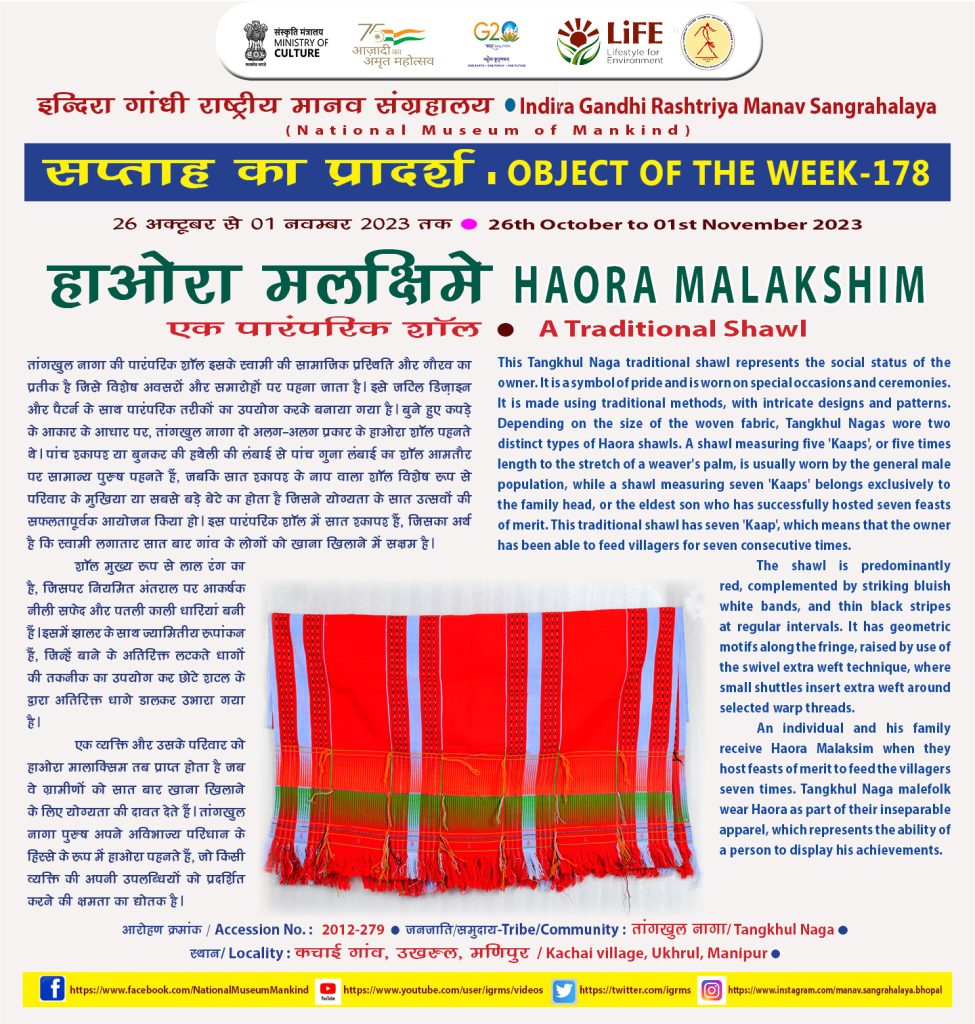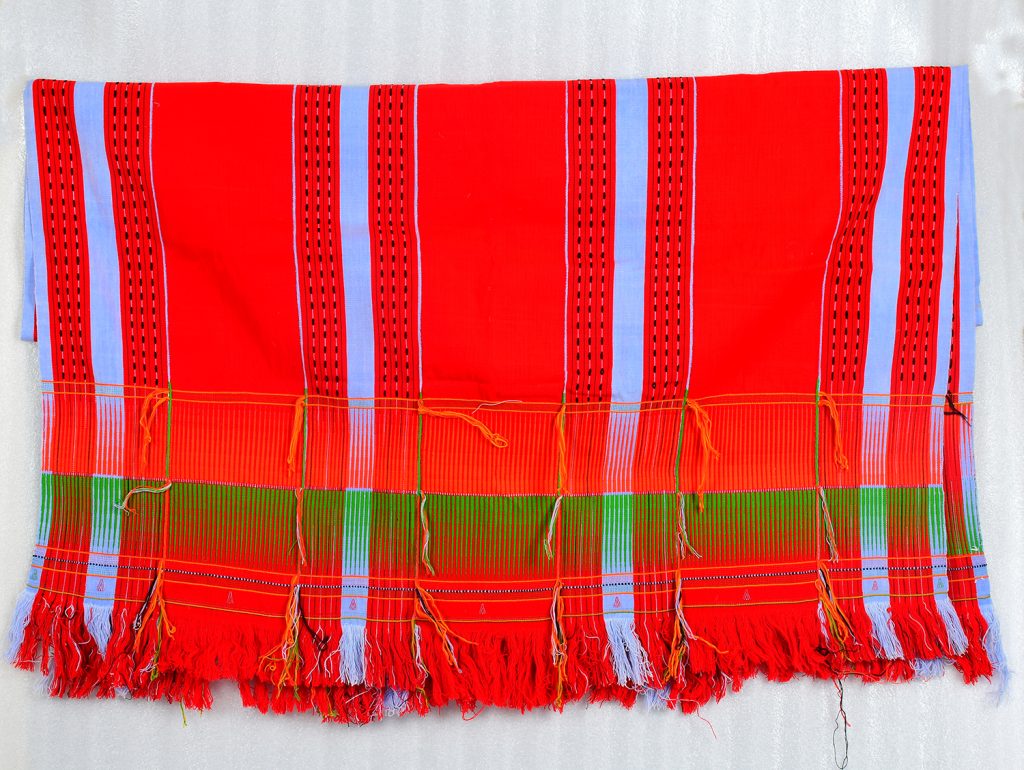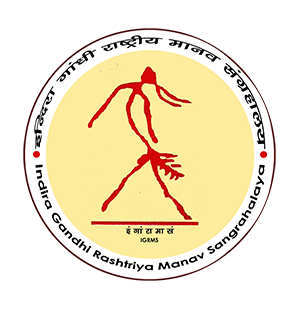सप्ताह का प्रादर्श-178
(26 अक्टूबर से 01 नवम्बर 2023 तक)
हाओरा मलक्षिम
एक पारंपरिक शॉल

तांगखुल नागा की पारंपरिक शॉल इसके स्वामी की सामाजिक प्रस्थिति और गौरव का प्रतीक है जिसे विशेष अवसरों और समारोहों पर पहना जाता है। इसे जटिल डिज़ाइन और पैटर्न के साथ पारंपरिक तरीकों का उपयोग करके बनाया गया है। बुने हुए कपड़े के आकार के आधार पर, तांगखुल नागा दो अलग-अलग प्रकार के हाओरा शॉल पहनते थे। पांच ‘काप’ या बुनकर की हथेली की लंबाई से पांच गुना लंबाई का शॉल आमतौर पर सामान्य पुरुष पहनते हैं, जबकि सात ‘काप’ के नाप वाला शॉल विशेष रूप से परिवार के मुखिया या सबसे बड़े बेटे का होता है जिसने योग्यता के सात उत्सवों की सफलतापूर्वक आयोजन किया हो। इस पारंपरिक शॉल में सात ‘काप’ हैं, जिसका अर्थ है कि स्वामी लगातार सात बार गांव के लोगों को खाना खिलाने में सक्षम है।
शॉल मुख्य रूप से लाल रंग का है, जिसपर नियमित अंतराल पर आकर्षक नीली सफेद और पतली काली धारियां बनी हैं। इसमें झालर के साथ ज्यामितीय रूपांकन हैं, जिन्हें बाने के अतिरिक्त लटकते धागों की तकनीक का उपयोग कर छोटे शटल के द्वारा अतिरिक्त धागे डालकर उभारा गया है।
एक व्यक्ति और उसके परिवार को हाओरा मालाक्सिम तब प्राप्त होता है जब वे ग्रामीणों को सात बार खाना खिलाने के लिए योग्यता की दावत देते हैं। तांगखुल नागा पुरुष अपने अविभाज्य परिधान के हिस्से के रूप में हाओरा पहनते हैं, जो किसी व्यक्ति की अपनी उपलब्धियों को प्रदर्शित करने की क्षमता का द्योतक है।
आरोहण क्रमांक. 2012-279
स्थानीय नाम: हाओरा मलक्षिम, एक पारंपरिक शॉल
स्थान: कचाई गांव, उखरुल, मणिपुर
कार्यात्मक श्रेणी: कपड़ा
समुदाय: तांगखुल नागा
Exhibit of the week- 178
(26th October to 01st November 2023)
HAORA MALAKSHIM
A Traditional Shawl
This Tangkhul Naga traditional shawl represents the social status of the owner. It is a symbol of pride and is worn on special occasions and ceremonies. It is made using traditional methods, with intricate designs and patterns. Depending on the size of the woven fabric, Tangkhul Nagas wore two distinct types of Haora shawls. A shawl measuring five ‘Kaaps’, or five times length to the stretch of a weaver’s palm, is usually worn by the general male population, while a shawl measuring seven ‘Kaaps’ belongs exclusively to the family head, or the eldest son who has successfully hosted seven feasts of merit. This traditional shawl has seven ‘Kaap’, which means that the owner has been able to feed villagers for seven consecutive times.
The shawl is predominantly red, complemented by striking bluish white bands, and thin black stripes at regular intervals. It has geometric motifs along the fringe, raised by use of the swivel extra weft technique, where small shuttles insert extra weft around selected warp threads.
An individual and his family receive Haora Malaksim when they host feasts of merit to feed the villagers seven times. Tangkhul Naga male folk wear Haora as part of their inseparable apparel, which represents the ability of a person to display his achievements.

Accn.No. 2012-279
Local Name: HAORA MALAKSHIM, A Traditional Shawl
Locality: Kachai village, Ukhrul, Manipur
Functional Category: Textile
Community: Tangkhul Naga
#haoramalakshim #shawlofmerit #feastofmerit #symbolofpride #warpandweft #weaving #weavingpattern #tangkhulnaga #naga #kachai #ukhrul #manipur #igrms #museumfromhome #objectoftheweek #ethnograhicobject #museumobject #museumofman #museumofmankind #museumofhumankind #experienceigrms #igrmsstories #staysafe



